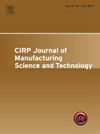Tailoring multiscale microstructures for balanced mechanical and thermal performance of difficult-to-process pure Al parts produced by laser powder bed fusion additive manufacturing
IF 5.4
2区 工程技术
Q2 ENGINEERING, MANUFACTURING
CIRP Journal of Manufacturing Science and Technology
Pub Date : 2025-04-05
DOI:10.1016/j.cirpj.2025.03.014
引用次数: 0
Abstract
Thermal management components usually require complex structures with a balance of mechanical and thermal performance. Laser powder bed fusion (LPBF) is a promising additive manufacturing technique for fabricating complex heat-dissipation structural components. However, pure aluminum has important application prospects in the field of heat dissipation, but its lower melting point and laser absorption rate compared to alloys result in difficult processing characteristics during LPBF, which remains poorly understood. This work systematically investigated the influence of laser processing on the multi-scale microstructural features and the synergistic effect on the mechanical and thermal performance of LPBF-fabricated pure Al parts. Results revealed that increasing the scanning speed from 0.6 m/s to 1.2 m/s leads to refined grains, increased dislocation density, decreased maximum orientation density along < 001 > direction, and a higher fraction of high-angle grain boundaries. These microstructural changes, coupled with the evolving porosity content, result in an initial enhancement followed by a decline in both the ultimate tensile strength and elongation of the fabricated parts. The thermal conductivity gradually decreases with the increase of scanning speed, which is due to the increased grain boundaries, dislocations, and stress that enhance the scattering behavior of electrons and phonons. The established processing-microstructure-property relationships provide critical insights for developing LPBF-processed Al based materials with an optimal balance between mechanical and thermal performance, enabling their widespread applications in structural and thermal management components.
采用激光粉末床熔融增材制造技术生产的难加工纯铝零件,为平衡机械和热性能定制多尺度显微组织
热管理组件通常需要复杂的结构,以平衡机械和热性能。激光粉末床熔融是一种很有前途的用于制造复杂散热结构部件的增材制造技术。然而,纯铝在散热领域具有重要的应用前景,但由于其熔点和激光吸收率较低,导致LPBF过程中的加工特性困难,这一点目前还不清楚。本文系统地研究了激光加工对lpbf制备纯铝零件的多尺度显微组织特征的影响以及对其力学和热性能的协同效应。结果表明:当扫描速度由0.6 m/s增加到1.2 m/s时,晶粒细化,位错密度增大,沿<方向最大取向密度减小;001比;方向,高角度晶界的比例较高。这些微观结构的变化,再加上孔隙率的不断变化,导致制造零件的极限抗拉强度和伸长率在初始增强后下降。随着扫描速度的增加,热导率逐渐降低,这是由于晶界、位错和应力的增加增强了电子和声子的散射行为。已建立的加工-微观结构-性能关系为开发lpbf加工的铝基材料提供了关键见解,这些材料具有机械性能和热性能之间的最佳平衡,使其在结构和热管理组件中得到广泛应用。
本文章由计算机程序翻译,如有差异,请以英文原文为准。
求助全文
约1分钟内获得全文
求助全文
来源期刊

CIRP Journal of Manufacturing Science and Technology
Engineering-Industrial and Manufacturing Engineering
CiteScore
9.10
自引率
6.20%
发文量
166
审稿时长
63 days
期刊介绍:
The CIRP Journal of Manufacturing Science and Technology (CIRP-JMST) publishes fundamental papers on manufacturing processes, production equipment and automation, product design, manufacturing systems and production organisations up to the level of the production networks, including all the related technical, human and economic factors. Preference is given to contributions describing research results whose feasibility has been demonstrated either in a laboratory or in the industrial praxis. Case studies and review papers on specific issues in manufacturing science and technology are equally encouraged.
 求助内容:
求助内容: 应助结果提醒方式:
应助结果提醒方式:


